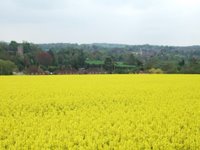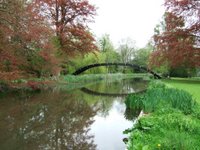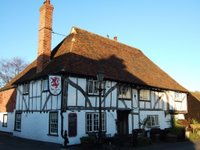
Rutland Water is the largest man made lake in Western Europe, and a very pleasant place for a sunny spring day. We spent a relaxing afternoon on Good Friday by the lake after a walk from Stamford to Ryall.
Stamford is a very beautiful stone town, used for all the town & village scenes in the latest production of Pride & Prejudice. The town escaped the industrial revolution because the family at the nearby great house of Burghley House refused to let the rail-way come & spoil 'their' town. This was probably an economical blow to the tradesmen of the time, but a bonus for the current tradesmen.

Easter Saturday started very misty & we walked from the picturesque town of Lyddington past another reservoir, used by the Lancaster bombers in WWII to practice night time bombing. We then visited the Bede House in Lyddington, originally a Bishop's Palace, stayed in by Henry 8th, later an Almshouse. A tour of the accommodation made us less than enthusiastic to have been a resident!
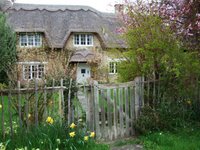
We then did a very interesting guided walking tour of Stamford, followed by a circular walk around Exton described as one of the loveliest villages in Rutland. It is certainly rates as one of the best we have visited.

The walk went from the estate village to a folly known as Fort Henry; built in 1788 by William Legg for Henry, Earl of Gainsborough the owner of Exton Park.
Sunday was lovely and sunny again. We did a morning walk around Belton-in-Rutland, and spent the afternoon visiting two country homes. The first, Deene Park, has a beautiful position, with gracious rooms opening onto a terrace leading to formal gardens with a lake beyond. It is still a beautiful home, obviously much loved by the current family. The second, Southwick Hall, was

two centuries older and consequently less comfortable, but obviously has had an interesting past.

We finished the day with a walk around Oundle, smaller than Stamford, but equally attractive. From there, we did a short walk to Ashton, a delightful village of thatched stone houses, rebuilt by the Rothschild family just over a hundred years ago. We had a lovely dinner in their equally beautiful thatched pub.

Easter Monday started with brilliant sunshine. We started the day visiting Hallaton, which has a fascinating Easter Monday tradition. First they share a hare pie & then compete with a near-by village in a 'bottle-kicking' competition. The 'bottles' are actually small casks of beer. We were too early for the action, so left to visit Grimsthorpe Castle. On the way we passed through Oakham and visited the castle. All that is left is the Great Hall, built 1190, the earliest surviving aisled stone hall in the country.

They have a tradition that visiting peers of the realm and royalty must present the Lord of the Manor with a horseshoe. The oldest to survive was presented by Edward IV in 1470 & the most recent by Princess Alexandra in 2005. The “horseshoes” are horseshoes in shape only, rather large and grandiose, depending on the donor.

The next interesting place we stumbled over was a topiary by
Clipsham, an amazing driveway to Clipsham Hall, now looked after by the Forestry Commission.

Grimsthorpe Castle, when we reached it, was most impressive and interesting. The family has the hereditary office of Lord Great Chamberlain. This means they have a collection of thrones from the House of Lords, used by previous monarchs.
The sun had been replaced by thunder storms by the time we left Grimsthorpe, and by the time we reached our final destination of Rockingham Castle, there was a terrific hail storm.
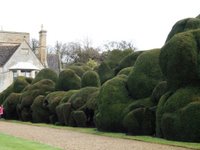
Rockingham Castle is 900 years old, and would have withstood many such storms and much worse over the centuries. For half of that period it was a royal fortress and the remaining 450 years a family home. An excellent video captured the sense of history very cleverly. The castle gave us a feeling of the past, but we enjoyed the grounds and the amazing view over the countryside more.
Bank holiday traffic never ceases to amaze us, and we returned to London in less than 2 hours.
 Some English country houses look so fascinating and inviting, you feel you would love to live in one & never leave. We walked around a beautiful country garden on Saturday, surrounding a house of this type.
Some English country houses look so fascinating and inviting, you feel you would love to live in one & never leave. We walked around a beautiful country garden on Saturday, surrounding a house of this type.  The property is called Vann and is open to the public for a very select number of days each year. Photos really don't do it justice.
The property is called Vann and is open to the public for a very select number of days each year. Photos really don't do it justice.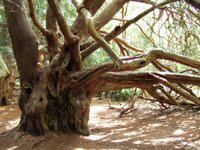 Our next walk was rather more strenuous. We looked around the Kingley Vale Nature Reserve, supposedly the largest yew forest in Europe, with trees up to 2000 years old. At that age yew trees have reached a stage where they have grown past being ungainly, and are handsome again. The branches sag to the ground, root at that point and put up leaders that repeat the cycle. One tree had two concentric rings of off-shoots, still connected back to the original trunk. The walk climbed a steep hill, with brilliant views, and took us on to the small village of Stoughton complete with the necessary excellent pub lunch.
Our next walk was rather more strenuous. We looked around the Kingley Vale Nature Reserve, supposedly the largest yew forest in Europe, with trees up to 2000 years old. At that age yew trees have reached a stage where they have grown past being ungainly, and are handsome again. The branches sag to the ground, root at that point and put up leaders that repeat the cycle. One tree had two concentric rings of off-shoots, still connected back to the original trunk. The walk climbed a steep hill, with brilliant views, and took us on to the small village of Stoughton complete with the necessary excellent pub lunch. 
 Sunday was overcast, hazy, cool, but fine. A harbour walk around Pagham Harbour was a peaceful start to the day, followed by two interesting country houses, both of which had been totally destroyed by fire. The first, Uppark, was destroyed by fire in 1989, and reopened 7 years later. They restored it to the same 'faded glory' it had before, so a visitor returning afterwards, would see it looking the same. Their display of techniques employed was very interesting. What they managed to salvage from a totally gutted shell is simply amazing.
Sunday was overcast, hazy, cool, but fine. A harbour walk around Pagham Harbour was a peaceful start to the day, followed by two interesting country houses, both of which had been totally destroyed by fire. The first, Uppark, was destroyed by fire in 1989, and reopened 7 years later. They restored it to the same 'faded glory' it had before, so a visitor returning afterwards, would see it looking the same. Their display of techniques employed was very interesting. What they managed to salvage from a totally gutted shell is simply amazing. The second house: Stanstead Park, was burnt down in 1903, and rebuilt in a grander style. After 100 years of wear and tear, this house also has a type of 'faded glory'.
The second house: Stanstead Park, was burnt down in 1903, and rebuilt in a grander style. After 100 years of wear and tear, this house also has a type of 'faded glory'.




